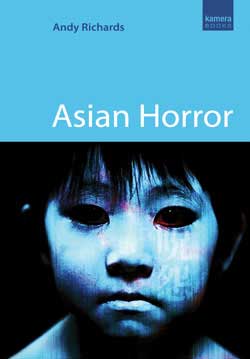I've been a fan of horror movies since I was a young kid. Yes, I was one of those weird kids who liked being scared. Except when I say scared, I really mean it. No "Goosebumps" kind of stuff for me - I went straight for the hardcore, pee-your-pants, can't-sleep-without-checking-under-the-bed stuff. I was a very quiet kid, kind of a loner, and horror brought me what I couldn't find in the "real" world - catharsis. If you knew me back then and then met me again today, you'd find yourself wondering what happened in the interim years. I'm a much more friendly, outgoing, happy person than I was decades ago.
But I still love being scared.
I've seen a few of the Asian horror movies discussed in this book. Well, I take that back; I've seen the Americanized versions of those movies. Yes, I'm talking about "The Ring" specifically, and "Dark Water", too. The only film mentioned in this wonderful little reference book that I have seen in its original version is "Audition", and I wouldn't have known about it without the fabulous people that brought us Bravo's Scariest Movie Moments. (Go find a copy of it with the subtitles and everything - it's a very disturbing, very powerful, very creepy film). I've also seen all the commercials for the multitude of American versions of other Asian horror movies, and I had noticed that they sort of all looked alike after a while. So I'm very happy to have picked up this book because it actually explained why they look alike (and no, it's not a copycat kind of thing).
Richards does an excellent job of giving the background and history of Asian ghost stories, ones that have been told for centuries, long before they became cinematic goldmines. For example, have you noticed that there seem to be a lot of creepy-looking girls with long black hair in these movies? Ones that are usually already dead, and thus ghosts, or ones that you're not sure if they're alive or dead? Especially ones that look at you through that long hair with only one eye visible? Welcome to the Asian prototype for the unquiet spirit, also know as yurei. They typically wear a white gown or another white outfit of some sort, and this is because in the original literature, they appeared in their burial kimonos. Their hair is down because that was how they were buried; while alive, women's hair was almost always worn up. And of course they are seeking revenge, having died violently by murder or suicide, and that revenge is not always restricted to the one(s) who wronged them.
In the same tradition, notice the extremely creepy cats in these movies. Those are bakeneko (literally 'cat demon'); these creatures are capable of possessing people and come into being when a cat licks the blood of its murdered owner. Finally, ever feel like you're drowning in a sea of watery images in these films? Yep, another classic trope - the well. Water and wells play a huge role in Asian literature as well as Asian horror movies, with water usually signifying a gateway to the underworld. Thus you get the girl trapped in the well in "The Ring", and pretty much the entire movie "Dark Water".
If you're interested in horror films and especially in tracing influences, cross-overs, and the like, then I would highly recommend this slim reference guide. Richards has a nice, easy style, and the book is arranged in chronological order, with older, classic Japanese movies explained first (such as "Godzilla"). Next up are the modern films, such as "The Ring". Then we move on to other Asian countries and some of the films they've produced, gems from Korea, Hong Kong, and Thailand. Finally, Richards wraps it up with a very aptly named chapter, "East Goes West: Lost in Translation?", an interesting discussion of how we take these Asian classics and alter them to fit our American tastes. No, it's not just dumping the subtitles that matters; you must also find a "name" to star in the American version, plus you have to ramp up the action while toning down the violence. No, you did not read that wrong - Asian horror in its original form is very, very violent, and includes all sorts of imagery that we Americans just don't seem comfortable with (and yes, I'm talking about sex here. We like our sex to be hot, even romantic at times, but we don't want it to be super-kinky, nor do we want it to be blended with torture).
Even better news is that this is an entry in a series of books about cinematic genres/directors/etc released by Kamera Books. The back of this book has a short blurb about the publisher, and their tag line is "Essential reading for anyone interested in film and popular culture." I noticed they have entries on horror films, spaghetti westerns, and even David Lynch! I'm hoping that our library system will have a few of these, as I'm anxious to try another one. I'll let you know if you should look for the whole series, and hopefully soon!

No comments:
Post a Comment